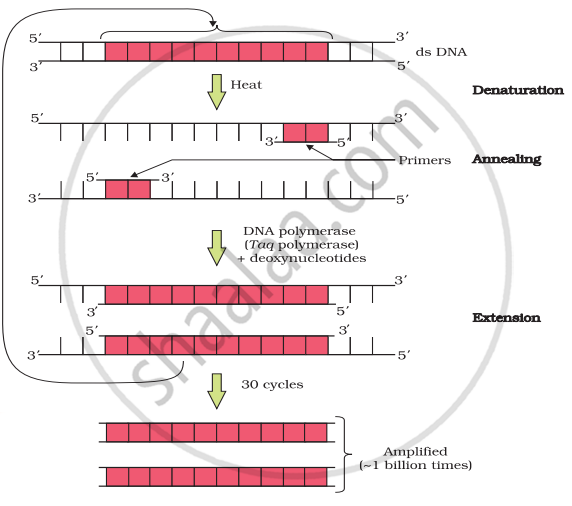Advertisements
Advertisements
Question
From what you have learnt, can you tell whether enzymes are bigger or DNA is bigger in molecular size? How did you know?
Solution
Enzymes are proteins. Protein molecules are macromolecules with highly complex structures. They are made up of amino acids. Around 300 types of amino acids are found in nature, but only 20 of these amino acids are found in animal and plant cells. Amino acids form chains and are linked to each other by peptide bonds. The sequence of amino acids in the polypeptide chain of each protein molecule is of a specific type. Proteins have very high molecular weight. Proteins made from different amino acids are of different types. Around 50,000 types of proteins are found in our body.
The biological macromolecules of DNA have a complex structure. These are biological macromolecules even larger than proteins (enzymes). Their molecular weight ranges from 106 to 109 Dalton. The DNA molecule is made up of a polynucleotide chain. m-RNA, t-RNA and r-RNA having molecular weight less than DNA are formed. RNA plays an important role in protein synthesis. For RNA synthesis, DNA molecule gets duplicated at different places and form small complementary chains, i.e. a small molecule of ribonucleotide acid. These are called primers. RNA: The synthesis of inserters is catalysed by the enzyme RNA polymerase. RNA molecules are used for protein synthesis. This makes it clear that DNA molecules are larger molecules than proteins (enzymes).
APPEARS IN
RELATED QUESTIONS
Name two commonly used bioreactors.
Can you list 10 recombinant proteins which are used in medical practice? Find out where they are used as therapeutics (use the internet).
Besides better aeration and mixing properties, what other advantages do stirred tank bioreactors have over shake flasks?
Explain briefly:
Chitinase
Answer the following question:
Describe the formation of recombinant DNA by the action of EcoRI.
In a pathological lab, a series of steps were undertaken for finding the gene of interest. Describe the steps, or make a flow chart showing the process of amplification of this gene of interest.
The first step in recombinant DNA technology is
In addition to the Taq polymerase enzyme, which other thermostable DNA polymerases have been isolated to be used in PCR?
Rising of dough is due to ______.
Which of the following should be chosen for best yield if one were to produce a recombinant protein in large amounts?
How is copy number of the plasmid vector related to yield of recombinant protein?
While doing a PCR, ‘denaturation’ step is missed. What will be its effect on the process?
Identify and explain steps ‘A’, ‘B’ and ‘C’ in the PCR diagram given below.

Illustrate the design of a bioreactor. Highlight the difference between a flask in your laboratory and a bioreactor which allows cells to grow in a continuous culture system.
Read the paragraph given below and answer and questions that follow:
| Enzyme Taq polymerase, is extracted from a eubacterial microorganism Thermus aquaticus from Yellowstone National Park in Montana, USA and isolated by Chien et al. (1976). Taq polymerase successfully replaced the DNA polymerase from E.coli that was being used in PCR earlier and this shift revolutionised the PCR technique. |
- Taq polymerase after its discovery replaced E.coli DNA polymerase in PCR technique. Explain giving reasons why was the need felt for the change?
- What is a primer and its importance in PCR?
- Write the importance of PCR as a diagnostic tool.
Read the following paragraph and answer the questions that follow:
| Biotechnology revolves around the "gene of interest", with an objective to open various avenues for human welfare in health, medicine, pharma, agriculture etc. using different techniques, tools and processes. One of the breakthroughs of biotechnology in medicine is the gene therapy. |
- Name the human disease for which the gene therapy was used for the first time.
- Explain the steps of gene therapy carried to cure the disease using the lymphocytes of the patient. Why is this therapy not a permanent cure of the disease?
- Write the possible permanent cure of the disease by the gene therapy that is in progress.
Assertion (A): Synthetic oligonucleotide polymers are used during Annealing in a PCR.
Reason (R): The primers bind to the double stranded DNA at their complementary regions.
Write the scientific name of the source organism of the thermostable DNA polymerase used in PCR.
Bioreactors are the containment vehicles of any biotechnology-based production process. For large scale production and for economic reasons the final success of biotechnological process depends on the efficiency of the bioreactor.
Answer the following questions w.r.t. the given paragraph:
- List the operational guidelines that must be adhered to so as to achieve optimisation of the bioreactor system. Enlist any four.
- Mention the phase of the growth we refer to in the statement "Optimisation of growth and metabolic activity of the cells".
- Is the biological product formed in the bioreactor suitable for the intended use immediate? Give reason in support of your answer.
